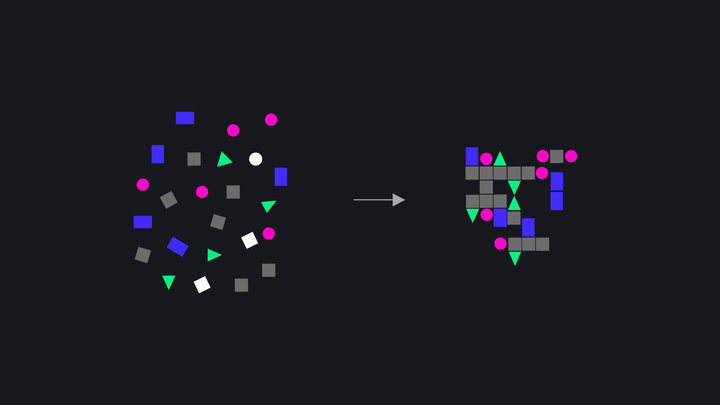In this article we'll explore one of the most important elements of Tana: the custom structures.
Let's go!
Why structures are important?
Key dialectics in knowledge work (and probably in the Universe): Entropy vs Information
If we try to simplify these concepts:
- Information defines order
- Entropy defines disorder
You locally reverse entropy.
That’s why you’re here.
– Naval Ravikant
Structures create local pockets of order and minimize entropy.
Throughout our history, humanity has created many information structures that have allowed us to make sense of the world and thrive.
Here are some historical examples
I Ching (Book of Changes)
Ancient divination tool. By interpreting I Ching hexagrams, people tried to gain insight into the patterns of the Universe and evaluate their own decisions made in high uncertainty.
Mandala
Geometric configurations of symbols, general representation of the cosmos. In Hindu and Buddhist traditions, it helps people to build the holistic model of the world and the interconnections between different beings and entities.
Sefirot
The system of elements and principles that represents the cosmic process. It offers a framework for understanding the relationship between life's different spheres/domains and divine/spiritual concepts.
Dharmachakra
Represents the framework of the Eightfold Noble Path. This path is a core aspect of Buddhist practice. Serves as a universal guide, helping individuals navigate life's complexities.
Since the dawn of our civilization, structures have allowed us to deal with the complexity of the world around us. Bring some form of order to the chaos of life.
But the true revolution happened when humanity discovered the scientific method: an approach to research that is based on empirical evidence, experimentation, and rational analysis.
Structures became the backbone of the most important scientific advancements.
The most canonical example here is the Periodic Table.
Dmitri Mendeleev basically created the scaffolding for the whole domain of chemistry.
Table allowed scientists to:
- build better explanations for chemical phenomena
- understand chemistry more comprehensively
- derive important general principles
- make significant scientific breakthroughs
The principles derived from the Periodic Table have influenced many other scientific fields, including physics, materials science, & biology.
Sensemaking
When the structure emerges from fragmented information and glimpses of meaning → it upgrades our understanding of the world.
Better structures → better explanations.
This the essence of the process of sensemaking.
Structures typology
This is my take on Francis Miller's work.
I'd say these 9 archetypes cover 80% of the case.
When you are dealing with a problem or exploring a new domain, try to think structurally.
Ask yourself: what archetype/archetypes underline this?
For example:
Timeline is the most obvious one: it underlines any historical research.
Case structure is extremely useful when you need to make a complex argument.
Layers are beneficial for any factor analysis. For example: Political/Economical/Social/Technological layers.
etc.
Any useful structure is usually composite: it combines several archetypes.
Building Structures in Tana
In Tana structures work as enabling constraints (following Dave Snowden's constraints typology)
We often see constraints as limitations or restrictions. Yet, it's not true for enabling constraints. On the contrary, enabling constraints facilitate our actions within a system, enabling certain behaviors & thinking patterns to emerge.
They are particularly important in complex environments like Tana when a variety of options and ways to do things is overwhelming. Enabling constraints help us to design the right environment for the problem we are working on.
CASE STUDY
I'm researching complex geopolitics now.
Before diving in, I built a scaffolding for this domain: 25 supertags: key domain-related concepts, categories & interrelations.
The exercise of building this ontology gave me a good initial understanding. It also reduced the anxiety of the uncharted territory.
This structure is a hybrid. It compounds several archetypes, mainly:
- Hierarchy is based on extensions of supertags.
- Relations are defined by fields.
I use this structure as the backbone of my research.
Now let's zoom in on one element: #treaty.
Treaties are fundamental in geopolitics.
So I made a separate supertag for them. It extends the #event supertag (which defines any historic event).
This #treaty structure is not generic!
I designed it specifically for my research project and my way of approaching this complex topic.
The structure is also hybrid:
it's a Category archetype, but it uses Timeline features as well.
In Tana, structures interact and interface via fields, extensions, and semantic functions.
They are easy to maintain. For example, if you want to change the field name, type, or function, all the changes will automatically apply throughout your workspace (however, in some cases, you will still need to do some manual work).
Tana AI for Builders can help you to create & sustain structures more efficiently.
For example, my #treaty structure heavily relies on AI and Commands to fill itself:
Timeframe & Period fields are filled automatically
Parties filed content got parsed from the Intro field.
So THIS is the SUPER-POWER of Tana!
Tana gives you the ability to build structures that reflect YOUR WAY of dealing with the specific topic and YOUR WAY of thinking.
And to not rely on the pre-defined stuff and pre-made primitives!
If you want to learn to build the structures and systems for your own work, in January I'm doing a second cohort of my course, Advanced Knowledge Systems in Tana.


